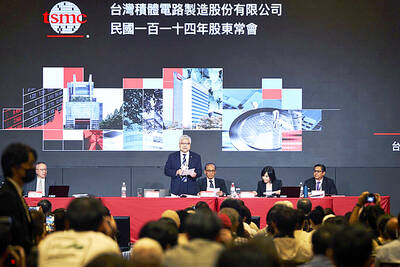China’s property sector shrank at a faster pace in the final three months of last year as the country’s housing slump continues to take its toll on the economy.
Output in the real-estate sector shrank 2.9 percent in the fourth quarter after a 1.6 percent contraction in the previous three months, the Chinese National Bureau of Statistics said yesterday in a supplemental report on GDP.
That was the first consecutive quarterly decline since 2008.
The construction sector’s output also declined by 2.1 percent during the same period.
Those two sectors combined were 13.8 percent of national output last year, Bloomberg calculations showed, lower than the 14.5 percent in 2020.
Despite authorities’ efforts to ease some restrictions on real-estate funding, China’s property market slump persisted last year, with the downturn spanning developers’ sales, investments, land purchasing and financing activities.
Property investment last month shrank 14 percent from a year earlier, Bloomberg calculations showed. For the full year, it grew 4.4 percent.
China’s economy in the fourth quarter of last year grew at the weakest pace in more than a year, weighed down by the housing slump and weak consumer spending, data released on Monday showed.
GDP expanded 4 percent from a year earlier, down from 4.9 percent in the previous quarter.
The Chinese National Development and Reform Commission said that the country has “relatively plenty” policy tools in reserve to cope with a challenging year ahead and that it would roll out these measures in a timely manner to stabilize growth.
Commission spokesman Yuan Da (袁達) told a news conference that the government would quickly roll out policy measures to boost domestic demand and study targeted measures to bolster industrial production.
The world’s second-largest economy rebounded last year with its best growth in a decade, helped by robust exports, but momentum is slowing on weakening consumption, weighed down by repeated COVID-19 outbreaks and a property downturn.
“We will continue to step up monitoring and forecasting of the economy, and study the policy tools in reserve, and roll out timely, relevant policy measures based on the need from the economic operations to ensure a stable, healthy and sustainable economic development,” Yuan said.
The Chinese central bank on Monday unexpectedly cut the borrowing costs of its medium-term loans for the first time since April 2020, with some market analysts expecting more policy easing this year to cushion an economic slowdown.
Yuan said that the economy faces many challenges this year, including weak consumption, constrained growth in investment and uncertainties in foreign trade, which have led to fluctuations in market expectations and corporate confidence.
The regulator approved 90 fixed-asset investment projects last year, worth a total of 775.4 billion yuan (US$122.20 billion).
Additional reporting by Reuters

CAUTIOUS RECOVERY: While the manufacturing sector returned to growth amid the US-China trade truce, firms remain wary as uncertainty clouds the outlook, the CIER said The local manufacturing sector returned to expansion last month, as the official purchasing managers’ index (PMI) rose 2.1 points to 51.0, driven by a temporary easing in US-China trade tensions, the Chung-Hua Institution for Economic Research (CIER, 中華經濟研究院) said yesterday. The PMI gauges the health of the manufacturing industry, with readings above 50 indicating expansion and those below 50 signaling contraction. “Firms are not as pessimistic as they were in April, but they remain far from optimistic,” CIER president Lien Hsien-ming (連賢明) said at a news conference. The full impact of US tariff decisions is unlikely to become clear until later this month

With an approval rating of just two percent, Peruvian President Dina Boluarte might be the world’s most unpopular leader, according to pollsters. Protests greeted her rise to power 29 months ago, and have marked her entire term — joined by assorted scandals, investigations, controversies and a surge in gang violence. The 63-year-old is the target of a dozen probes, including for her alleged failure to declare gifts of luxury jewels and watches, a scandal inevitably dubbed “Rolexgate.” She is also under the microscope for a two-week undeclared absence for nose surgery — which she insists was medical, not cosmetic — and is

GROWING CONCERN: Some senior Trump administration officials opposed the UAE expansion over fears that another TSMC project could jeopardize its US investment Taiwan Semiconductor Manufacturing Co (TSMC, 台積電) is evaluating building an advanced production facility in the United Arab Emirates (UAE) and has discussed the possibility with officials in US President Donald Trump’s administration, people familiar with the matter said, in a potentially major bet on the Middle East that would only come to fruition with Washington’s approval. The company has had multiple meetings in the past few months with US Special Envoy to the Middle East Steve Witkoff and officials from MGX, an influential investment vehicle overseen by the UAE president’s brother, the people said. The conversations are a continuation of talks that

CHIP DUTIES: TSMC said it voiced its concerns to Washington about tariffs, telling the US commerce department that it wants ‘fair treatment’ to protect its competitiveness Taiwan Semiconductor Manufacturing Co (TSMC, 台積電) yesterday reiterated robust business prospects for this year as strong artificial intelligence (AI) chip demand from Nvidia Corp and other customers would absorb the impacts of US tariffs. “The impact of tariffs would be indirect, as the custom tax is the importers’ responsibility, not the exporters,” TSMC chairman and chief executive officer C.C. Wei (魏哲家) said at the chipmaker’s annual shareholders’ meeting in Hsinchu City. TSMC’s business could be affected if people become reluctant to buy electronics due to inflated prices, Wei said. In addition, the chipmaker has voiced its concern to the US Department of Commerce